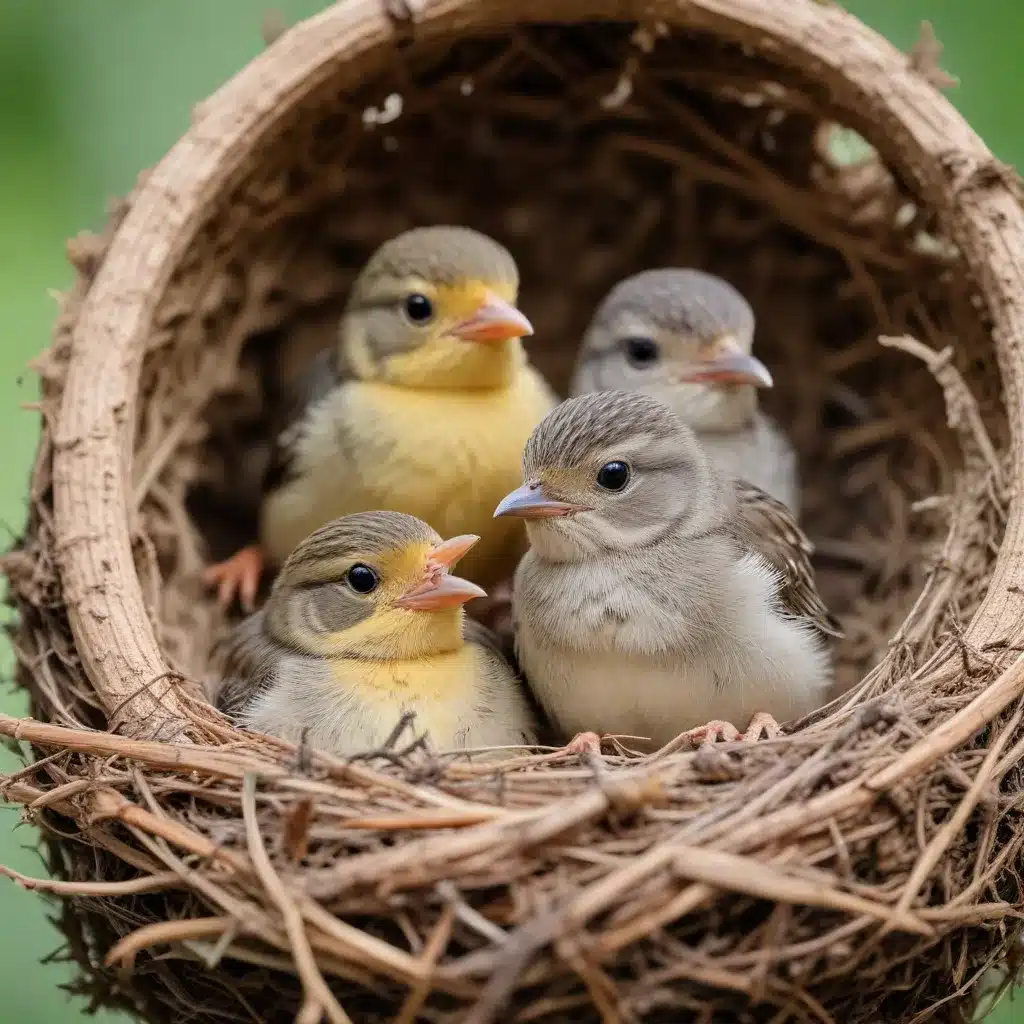
Avian Anatomy and Behavior
As an experienced avian caretaker, I’ve had the privilege of observing the endearing curiosity and resilience of fledgling birds up close. These young feathered friends are in a critical transitional stage, having just left the nest but not yet fully capable of independent flight and survival.
Baby birds are fascinating creatures, with distinctive physical characteristics and behaviors that set them apart from their adult counterparts. Fledglings typically have downy, fluffy plumage, short tails, and underdeveloped wings that make powered flight a challenge. Their legs are often proportionately larger, allowing them to perch and hop about as they learn to navigate their environment.
The fledgling stage represents a crucial period of rapid growth and development. Newly hatched chicks start off completely dependent on their parents for food and care. As they mature, they gradually gain the necessary skills and strength to become self-sufficient. First comes the ability to thermoregulate their own body temperature, then the coordination to forage and eventually fly. This transitional period lasts around 2-4 weeks, during which time the young birds are particularly vulnerable.
Driven by an innate sense of curiosity, fledglings are compelled to explore their surroundings. They hop, flutter, and scramble, investigating every nook and cranny. This adventurous spirit, while endearing, also puts them at heightened risk of encountering household hazards or finding themselves in precarious situations. As their caretakers, it’s our responsibility to make our homes and yards as safe as possible for these precious babies.
Home Hazards for Fledgling Birds
The world can be a treacherous place for young, inexperienced birds. Within the confines of our own homes and outdoor spaces, there are numerous potential dangers that fledglings may encounter. From common household items to environmental threats, it’s crucial to be aware of the risks and take proactive steps to minimize them.
One of the biggest threats to fledglings are windows. Reflective glass can appear as an open pathway, leading birds to collide with the surface at high speeds. These impacts can result in serious injury or even death. Equally perilous are open doors and windows, which offer tempting avenues for exploration but quickly become traps that prevent the birds from finding their way back outside.
The home interior also holds many hazards. Curious fledglings may stumble into bathtubs, sinks, or other water-filled receptacles and become trapped. Loose wires, open toilet lids, and even ceiling fans pose serious risks of entanglement or blunt trauma. Curious beaks can also become stuck in small openings, such as those found in certain types of furniture or appliances.
Outdoors, the dangers only multiply. Uncovered trash cans, swimming pools, and machinery can all become deadly pitfalls for young birds. Predators, both domestic and wild, also pose a grave threat. Cats, dogs, and even native species like hawks or raccoons may view fledglings as easy prey. The elements, too, can be unkind – exposure to extreme temperatures, dehydration, and inclement weather can quickly overwhelm a baby bird’s delicate constitution.
Avian-Friendly Home Modifications
Fortunately, there are many simple steps we can take to fledgling-proof our homes and outdoor spaces. By making a few strategic adjustments, we can create a safer, more welcoming environment for our feathered friends.
One of the most effective measures is to treat windows with specialized film, stickers, or netting. These visual markers break up the reflection, alerting birds to the presence of the glass barrier. Keeping doors and windows closed, especially during the peak fledgling season, is also crucial.
Within the home, securing potential entrapment risks is key. Cover open toilet lids, install safety guards on ceiling fans, and tuck away loose wires. Ensure that sinks, bathtubs, and other water sources are inaccessible to curious beaks and feet. For outdoor spaces, invest in sturdy trash can lids, pool covers, and predator-proof fencing to deter unwanted visitors.
But our efforts shouldn’t stop at just creating a safe haven. We can also provide supportive resources to help fledglings thrive. Strategically placed birdbaths, feeding stations, and dense vegetation offer much-needed sustenance and shelter. Carefully selected native plants can also attract beneficial insects and other food sources to support the local avian population.
Caring for Injured or Orphaned Fledglings
Despite our best efforts, sometimes we may encounter fledglings in distress. Perhaps a baby bird has fallen from its nest, or we’ve witnessed an attack by a predator. In these situations, it’s crucial to resist the urge to “rescue” the bird ourselves and instead contact a licensed wildlife rehabilitation center.
These specialized facilities are equipped to provide the proper care and treatment that injured or orphaned fledglings require. Their trained staff can assess the bird’s condition, administer first aid if necessary, and develop a tailored plan for rehabilitation and eventual release back into the wild.
In the meantime, there are a few steps we can take to support these vulnerable birds. Observe the fledgling from a safe distance, noting any obvious signs of injury or distress. Refrain from touching or attempting to feed the bird, as this can do more harm than good. If the fledgling appears to be in immediate danger, you may carefully contain it in a ventilated box or carrier and transport it to the nearest wildlife rehab center.
By understanding the unique needs and challenges facing fledgling birds, and taking proactive measures to create a safe haven in our own homes and yards, we can help ensure the continued health and success of our local avian populations. After all, these curious, fluffy-feathered babies are the future of our vibrant backyard ecosystems.


